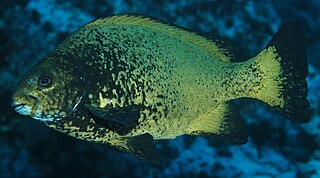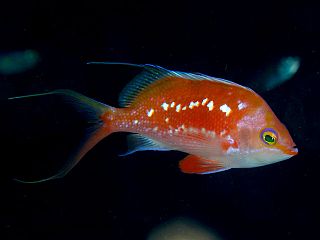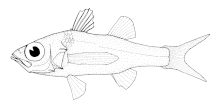Grammatidae is a small family of ray-finned fishes which were formerly placed in the order Perciformes but are now regarded as being incertae sedis in the subseries Ovalentaria in the clade Percomorpha. They are commonly known as basslets. They are marine fish found in the tropical western Atlantic Ocean.

The longfins, also known as roundheads or spiny basslets, are a family, Plesiopidae, which were formerly placed in the order Perciformes but are now regarded as being incertae sedis in the subseries Ovalentaria in the clade Percomorpha. They are elongated fishes, found in the Indian Ocean and western Pacific Ocean.

The pelagic basslet is an oceanic basslet native to the Indo-Pacific, where it occurs at depths from 100 to 1,829 m. This species is an openwater fish, staying deeper during the day and moving to shallower waters. This species can reach 7.6 cm (3.0 in) in TL.

Pseudanthias is a genus of colourful reef fishes of the subfamily Anthiinae, part of the family Serranidae, the groupers and sea basses. They are found in the Indo-Pacific. The species belonging to this genus have a diet consisting of zooplankton, and are haremic. Fishes currently included in this genus were earlier part of the genus Anthias. Pseudanthias is the largest anthiine genus

Percoidei is one of 3 suborders of bony fishes in the order Perciformes. Many commercially harvested fish species are considered to be contained in this suborder, including the snappers, groupers, basses, goatfishes and perches.

Pseudanthias huchtii, the red cheek fairy basslet, threadfin anthias or Pacific basslet is a species of marine ray-finned fish, a member of the genus Pseudanthias which is part of the subfamily Anthiinae, which in turn is part of the family Serranidae, the groupers and sea basses. It comes from the Western Central Pacific Ocean. It occasionally makes its way into the aquarium trade. It grows to a size of 12 cm in length.

Paranotothenia magellanica, also known as Magellanic rockcod, Maori cod, blue notothenia or orange throat notothen, is a species of marine ray-finned fish, belonging to the family Nototheniidae, the notothens or cod icefishes. It is native to the Southern Ocean. "Maori chief" and "black cod", sometimes used for this species, usually refer to fishes from the related genus Notothenia. Being a perciform fish, it is unrelated to the true cods of the order Gadiformes. This species is commercially important as a food fish.

The oceanic basslets are ray-finned fish that belong to the small family Howellidae within the order Acropomatiformes. The family includes about 9 species. They are mostly deep-water species, some of which move to shallower waters at night. Various species are found in the Indian Ocean, Pacific Ocean, including the Coral Sea, and Atlantic Ocean, including the Caribbean Sea.

Gramma is a genus of fishes native to tropical waters of the western Atlantic Ocean and the Caribbean Sea.

Lipogramma is a genus of fish in the family Grammatidae native to the western Atlantic Ocean.
Bathysphyraenops is a genus of ray-finned fish in the family Howellidae, the oceanic basslets. They are native to the deep waters of the tropical oceans.
Nototheniops is a genus of marine ray-finned fishes belonging to the family Nototheniidae, the notothens or cod icefishes. The species in this genus are native to the Southern Ocean.

Liopropoma is a genus of marine ray-finned fish, related to the groupers and included in the subfamily Epinephelinae, part of the family Serranidae, which also includes the anthias and sea basses. They are sometimes seen in the marine aquarium trade.

Tosanoides is a genus of marine ray-finned fish in the subfamily Anthiinae which is part of the family Serranidae, the groupers and sea basses. They are found in the Atlantic and Pacific Ocean.

Sacura is a genus of fish in the family Serranidae found in the Indian and Pacific Ocean.
Selenanthias is a genus of fish in the family Serranidae native to the western and central Pacific Ocean.
Basslet is a common name for several fishes and may refer to:
The barred spiny basslet is a species of ray-finned fish in the family Plesiopidae, the longfins or roundheads. It occurs on reefs in the western Pacific Ocean from Japan south to Australia and east to New Caledonia. It is the only species in its genus.
Jeboehlkia is a monotypic genus of marine ray-finned fish, related to the groupers and classified within the subfamily Epinephelinae of the family Serranidae. It is a species of relatively deep water which is found in the western Atlantic Ocean. The only species in the genus is Jeboehlkia gladifer, the bladefin bass.

Howella atlantica, commonly known as the Atlantic pelagic basslet and the Atlantic pricklefish, is a species of teleost fish in the oceanic basslet family Howellidae.













